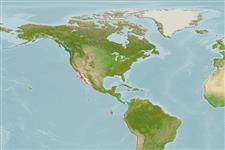>
Anguilliformes (Eels and morays) >
Muraenidae (Moray eels) > Muraeninae
Etymology: Gymnothorax: Greek, gymnos = naked + Greek, thorax, -akos = breast (Ref. 45335).
More on author: Ayres.
Environment: milieu / climate zone / depth range / distribution range
Ökologie
seewasser demersal; tiefenbereich 1 - 40 m (Ref. 35581). Subtropical; 34°N - 2°S, 121°W - 90°W (Ref. 96339)
Eastern Pacific: Point Conception in California, USA to southern Baja California in Mexico. Also known from the Galapagos Islands (Ref. 35581).
Size / Gewicht / Alter
Maturity: Lm ? range ? - ? cm
Max length : 152 cm TL Männchen/unbestimmt; (Ref. 2850); max. veröff. Alter: 30 Jahre (Ref. 56049)
Kurzbeschreibung
Bestimmungsschlüssel | Morphologie | Morphometrie
Rückenflossenstacheln (insgesamt) : 0; Afterflossenstacheln: 0; Wirbelzahl: 146 - 154.
Found common among rocks; lives in crevices or holes, usually with only head protruding. Very common in shallow reef areas (Ref. 35581). Feed mostly at night on crustaceans, octopuses and small fishes. Long-lived. Pelagic spawners (Ref. 56049).
Life cycle and mating behavior
Maturities | Fortpflanzung | Spawnings | Egg(s) | Fecundities | Larven
Oviparous. Pelagic spawner (Ref. 56049).
Eschmeyer, W.N., E.S. Herald and H. Hammann, 1983. A field guide to Pacific coast fishes of North America. Boston (MA, USA): Houghton Mifflin Company. xii+336 p. (Ref. 2850)
IUCN Rote Liste Status (Ref. 130435)
Bedrohung für Menschen
Traumatogenic (Ref. 4690)
Nutzung durch Menschen
Fischereien: kleinfischerei; Aquarium: Öffentliche Aquarien
Tools
Zusatzinformationen
Download XML
Internet Quellen
Estimates based on models
Preferred temperature (Ref.
123201): 18 - 28.3, mean 25.3 °C (based on 18 cells).
Phylogenetic diversity index (Ref.
82804): PD
50 = 0.5000 [Uniqueness, from 0.5 = low to 2.0 = high].
Bayesian length-weight: a=0.00047 (0.00025 - 0.00089), b=3.28 (3.13 - 3.43), in cm total length, based on LWR estimates for this Genus-body shape (Ref.
93245).
Trophic level (Ref.
69278): 4.5 ±0.8 se; based on diet studies.
Widerstandsfähigkeit (Ref.
120179): niedrig, Verdopplung der Population dauert 4,5 - 14 Jahre. (tmax=30).
Fishing Vulnerability (Ref.
59153): Very high vulnerability (90 of 100).
